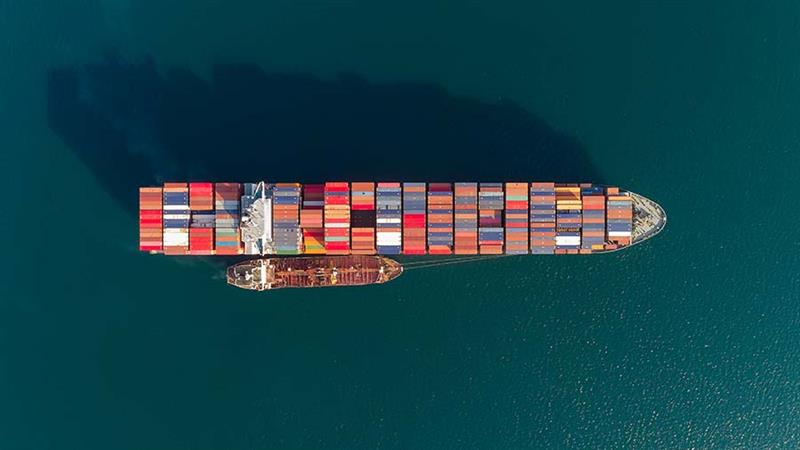Next time you’re tempted to raid the pantry for snacks loaded with saturated fat — especially in winter — you might want to consider that the result could be cravings for more high-calorie nibbles.
That’s because, from the…

Next time you’re tempted to raid the pantry for snacks loaded with saturated fat — especially in winter — you might want to consider that the result could be cravings for more high-calorie nibbles.
That’s because, from the…

China’s green bunkering market is entering an early but pivotal phase as the global maritime industry transitions toward low- and zero-emission fuels. Driven by regulatory pressure, domestic policy support, and growing pilot projects in major ports, China is positioning itself as a leader in green methanol, ammonia, and biofuel supply. For investors and operators, the market presents both new growth opportunities and uncertainty amid an evolving policy, infrastructure, and demand landscape.
Renewable marine fuels are emerging as an exciting frontier in the global energy transition. As international shipping faces mounting regulatory and market pressure to decarbonize, attention has turned to the supply of low- and zero-emission fuels such as methanol, ammonia, hydrogen, and biofuels for ships. However, the industry remains in its infancy, and a combination of uncertain demand, incomplete infrastructure, and underdeveloped regulatory systems means the industry poses both high risk and offers high potential rewards.
China is playing a critical role in the development of the industry, with expanding policy and regulatory frameworks and growing pilot activity. As the world’s largest trading nation, shipbuilder, and emitter, it plays a crucial role in addressing the challenge of maritime decarbonization. In recent years, it has moved rapidly from concept to early commercialization of green bunkering fuels, led by ports such as Shanghai, Dalian, and Ningbo-Zhoushan.
Investors considering whether to enter the market must weigh the opportunities for growth, alignment with ESG and carbon reduction targets, and potential policy support against high upfront costs, safety and infrastructure challenges, and uncertainties around adoption rates.
China’s drive to develop green bunkering fuel reflects both its climate commitments and its position as the world’s largest shipbuilding and exporting nation. As the world’s largest emitter of greenhouse gases, China must decarbonize major sectors to meet its “dual carbon” goals of reaching peak emissions before 2030 and carbon neutrality by 2060. Shipping is responsible for 2 to 3 percent of global emissions and is therefore a growing focus for China.
Find Business Support
As a member of the International Maritime Organization (IMO), China is also aligning with the 2023 IMO Strategy on the Reduction of GHG Emissions from Ships, which calls for a 40 percent cut in carbon intensity by 2030 and at least five percent adoption of zero or near-zero emission fuels. Developing green bunkering fuels such as methanol, ammonia, hydrogen, and biofuels is therefore essential for China to remain compliant and competitive.
Domestically, green bunkering supports China’s goal of becoming a leader in clean maritime technology and fuel supply. Pilot projects in Shanghai, Shenzhen, Dalian, and Hainan are building out methanol and biofuel bunkering capacity, while research into ammonia and hydrogen fuels is advancing. These efforts strengthen China’s role in shaping global low-carbon shipping standards and position its ports as future regional bunkering hubs.
The global bio bunker fuel market is entering a rapid growth phase as decarbonization targets reshape the shipping industry. Valued at US$407.6 million in 2024, the market is projected to expand at a strong compound annual growth rate (CAGR) of 11.4 percent, reaching US$1.35 billion by 2035, according to research by Fact.MR.
Find Business Support

China is expected to be one of the fastest-growing markets, reaching US$234.5 million by 2035 at a CAGR of 11.7 percent, creating around US$157 million in new opportunities over the decade.
Globally, the clean bunkering landscape is maturing quickly. A report from the Global Maritime Forum released in August 2025 noted that methanol has moved beyond proof of concept, with around 60 methanol-capable vessels already operating, more than 300 ships on order, and nearly 20 ports offering green methanol bunkering. Meanwhile, ammonia is “rapidly approaching proof of concept,” with pilot vessels at sea, engine testing nearing completion, and early bunkering trials underway at major ports.
China’s push into green bunker fuels accelerated sharply in 2024 and 2025, with a series of milestones that positioned its ports and shipyards at the forefront of maritime decarbonization. These milestones show China’s rapid progression from pilot-scale biofuel bunkering to a multi-fuel, multi-port ecosystem.
Shanghai – April 10, 2024: The Yangshan Deepwater Port completes China’s first ship-to-ship methanol bunkering. The supply vessel Haigang Zhiyuan delivered 504 tonnes of green methanol to the methanol-powered containership Astrid Maersk while cargo operations continued. This operation demonstrated the technical feasibility of simultaneous bunkering and cargo handling, positioning Shanghai as the first Chinese port capable of supporting international methanol-fueled vessels.
Shenzhen – April 24, 2024: The bunkering vessel “Antong 27” in the Port of Shenzhen bunkered the Liberia-flagged containership Anming with 500 tonnes of B24 biofuel oil and 500 tonnes of low-sulfur fuel oil at Yantian Port. The B24 blend, containing 24 percent biodiesel, reduced carbon emissions by roughly 20 percent. This operation marked Shenzhen’s first international biofuel bunkering and highlighted the city’s commitment to developing a green shipping fuel hub, complete with safety protocols and compliance with international certification standards.
Shanghai – June 20, 2025 – COSCO SHIPPING delivered the “COSCO Shipping Yangpu”, China’s first 16,000 TEU methanol dual-fuel containership built domestically, equipped with a home-produced methanol main engine, to Changxing Island in Shanghai. This vessel was the first domestic order for a ship of this type, the first delivery from a domestic shipyard, and the first onboard installation of a Chinese-made methanol engine.
Hainan – July 2, 2025: The Yangpu received its first bunkering of domestically produced green methanol at Hainan’s Yangpu Port, totaling 200 tonnes derived from food waste and biogas. This operation closed the full domestic supply chain from production to bunkering, proving the feasibility of an entirely Chinese methanol fuel ecosystem and providing a replicable model for global maritime decarbonization.
Dalian – July 15, 2025 – Dalian’s Dayao Bay Port Area completed the first bonded green methanol bunkering in Northeast China for the Yangpu, supplying 500 tonnes sourced from Heilongjiang and Inner Mongolia. The fuel was ISCC-certified and achieved over 100 percent carbon reduction in certain batches. This milestone established a fully integrated bonded supply chain for international vessels, linking production, transportation, storage, and bunkering in Northeast Asia.
Dalian – July 22, 2025 – COSCO Shipping Kawasaki launched construction of the first of a series of 24,000 TEU methanol dual-fuel containerships in Dalian. The same week, Dalian completed the world’s first green ammonia bunkering, supplying a port vessel equipped with a domestically developed ammonia dual-fuel engine. Using 100 percent renewable electricity, the ammonia operation made Dalian the only port globally capable of bunkering biofuel, methanol, LNG, and ammonia, reinforcing its role as a regional green fuel hub.
Tianjin – July 23, 2025: Tianjin’s Dagukou Port Area shipped 5,000 tonnes of green methanol to Singapore, produced in Inner Mongolia from waste tires and agricultural residues. Managed by Hong Kong & China Gas and Vopak, the operation formed a seamless production-to-export supply chain, demonstrating the capacity for Chinese green fuels to support international shipping while integrating domestic production, storage, and logistics networks.
Ningbo – September 29, 2025: At Meishan Terminal in the Port of Ningbo-Zhoushan, the 20,000 TEU methanol dual-fuel containership COSCO Shipping Libra completed the port’s first green methanol bunkering, receiving approximately 222 tonnes of fuel via a shore-based skid unit. The operation marked Zhejiang Province’s first-ever green methanol bunkering, establishing a milestone for the region’s low-carbon shipping infrastructure.
China is currently building out a policy framework for advancing the development of green bunker fuels. One of the core policy documents is the Action Plan for the Green Development of the Shipbuilding Industry (2024–2030), which provides a national framework for transforming China’s shipbuilding sector through the adoption of low- and zero-carbon fuels such as LNG, methanol, ammonia, and hydrogen. It links ship design, propulsion innovation, and energy infrastructure to the country’s broader carbon reduction and maritime decarbonization goals.
By 2025, the Action Plan aims to:
By 2030, the plan seeks to:
Beyond these milestones, the policy outlines a strategy to accelerate the development of new vessel types and propulsion technologies. It calls for the rapid scaling of LNG-powered ships and the advancement of methanol, ammonia, and hydrogen-powered designs. The plan promotes pilot projects for electrified coastal and inland ships, alongside the retrofitting of existing vessels to reduce emissions through energy-efficient upgrades.
Research and development of green marine power systems is also highlighted, including higher-efficiency LNG engines, methanol and ammonia engines across full power ranges, and exploration of fuel cell, battery, and hydrogen propulsion technologies. Supporting systems, such as fuel supply infrastructure, exhaust treatment, and emissions monitoring, are to be developed in parallel to ensure the safe, scalable use of new bunker fuels.
China’s regulatory framework for green bunkering is still in its formative stages. While there are currently no unified national regulations governing the use, handling, or safety of alternative marine fuels, several coastal provinces and municipal maritime authorities have begun drafting local rules to provide interim guidance and safety oversight. These early initiatives reflect the gradual institutionalization of green bunkering operations within China’s broader maritime regulatory system.
Key local and draft regulations include:
There are currently no formal regulations or technical guidelines for ammonia bunkering, reflecting the fact that ammonia-fueled vessels and infrastructure remain at a very early stage of development.
On the market side, China’s regulatory environment is open to both domestic and foreign participation. Green marine fuels are listed in the Catalogue of Industries for Encouraging Foreign Investment (2022 Edition) under the category of clean and new energy propulsion technologies, including LNG, hydrogen fuel cells, methanol, ammonia, and biomass fuels.
This “encouraged” designation carries several benefits for foreign investors:
China’s green bunkering market is still in its infancy, but the growth prospects are significant if the uptake takes off. As global and domestic pressure mounts to decarbonize maritime transport, demand for cleaner marine fuels is expected to surge. The International Maritime Organization’s emission targets, combined with China’s dual-carbon pledges, ensure that low- and zero-emission fuels will gradually shift from pilot stage to commercial necessity. Early entrants will therefore benefit from first-mover advantages in a market that could become central to Asia’s green shipping corridors.
Major shipping companies, including Maersk, COSCO, and HMM, have set their own carbon neutrality goals. Partnering with these firms or supplying green bunkering solutions aligns directly with global ESG priorities, creating opportunities for long-term partnerships and favorable financing from sustainability-focused investors.
Green bunkering fits squarely within China’s industrial and environmental policy priorities. The government has already laid out detailed targets for expanding methanol, ammonia, and hydrogen-powered vessels under its policy framework. As pressure ramps up to decarbonize hard-to-abate industries, it is highly likely the government will roll out more preferential policies and incentive measures to encourage uptake, which could include new financing opportunities, tax incentives, preferential policies for access to land and resources, and other administrative support for both foreign and domestic companies.
In the long term, investment in green fuels offers a hedge against exposure to volatile fossil fuel prices and rising carbon costs. As carbon trading mechanisms expand in China’s transport and industrial sectors, low-carbon fuels could gain a competitive edge over conventional marine fuels.
At present, the cost of producing and supplying green methanol, ammonia, or biofuels remains significantly higher than that of conventional marine fuel. According to the International Renewable Energy Agency (IRENA), hydrogen-based bunker fuels such as ammonia and methanol “will not beat fossil fuels on price until 2040”. With limited economies of scale and few established supply chains, profitability in the short term will therefore depend on government incentives or green premiums paid by shipping customers.
Perhaps the greatest uncertainty lies in the pace of adoption. For the shipping industry to meet its decarbonization goals, zero-emission fuels must scale rapidly around 2030. Yet, the depth of market uptake remains unclear. For methanol, the key challenge is securing sufficient green feedstock; for ammonia, it is the absence of commercial bunkering infrastructure at major ports. Until these issues are resolved, demand will remain uneven and localized.
China’s bunkering network for green fuels is developing quickly but remains uneven. Only a handful of ports currently have pilot facilities for methanol or biofuels, while ammonia and hydrogen bunkering are still in experimental stages. The absence of national safety and technical regulations also poses operational uncertainty for investors.
Handling new fuels such as methanol and ammonia involves distinct safety challenges. Both are toxic and require specialized storage, transfer, and emergency response systems. This means operators will need to invest in personnel training and safety guidelines, which adds to both the risks and costs of adoption.
China’s green bunkering industry remains in its early commercial phase, dominated by state-owned enterprises such as COSCO Shipping Energy Transportation and its subsidiary China Marine Bunker (CHIMBUSCO). While foreign firms are unlikely to operate independently in bunkering today, there are several pragmatic pathways for market entry, often centered on partnerships, technology provision, or fuel supply collaborations.
Related Reading

One of the clearest examples is Maersk’s collaboration with Shanghai International Port Group (SIPG). On March 27, 2023, the Danish shipping giant signed a memorandum of understanding (MoU) with SIPG to cooperate on a Shanghai Port methanol marine fuel project, reflecting a model where foreign shipping companies provide demand and technical expertise while leveraging local infrastructure. Similarly, on April 3, 2024, South Korea’s HMM signed an MoU with SIPG to explore clean marine fuel supply, specifically targeting methanol and LNG bunkering at Shanghai Port. Both cases demonstrate that joint projects with port operators are the most viable entry point for foreign players, allowing access to infrastructure and fuel logistics networks without direct operational control.
Other entry scenarios include joint ventures with SOEs, particularly in fuel production, bunkering vessel operations, or port storage facilities. Foreign technology providers can also participate by supplying fuel handling systems, monitoring and safety technologies, or advanced propulsion solutions.
Additionally, as green fuel certification, carbon accounting, and lifecycle emissions tracking gain prominence, foreign firms can harness new opportunities by providing verification, digital monitoring, or consulting services, establishing early relationships with port authorities and SOEs while the broader ammonia, methanol, and hydrogen bunkering markets mature.
About Us
China Briefing is one of five regional Asia Briefing publications. It is supported by Dezan Shira & Associates, a pan-Asia, multi-disciplinary professional services firm that assists foreign investors throughout Asia, including through offices in Beijing, Tianjin, Dalian, Qingdao, Shanghai, Hangzhou, Ningbo, Suzhou, Guangzhou, Haikou, Zhongshan, Shenzhen, and Hong Kong in China. Dezan Shira & Associates also maintains offices or has alliance partners assisting foreign investors in Vietnam, Indonesia, Singapore, India, Malaysia, Mongolia, Dubai (UAE), Japan, South Korea, Nepal, The Philippines, Sri Lanka, Thailand, Italy, Germany, Bangladesh, Australia, United States, and United Kingdom and Ireland.
For a complimentary subscription to China Briefing’s content products, please click here. For support with establishing a business in China or for assistance in analyzing and entering markets, please contact the firm at china@dezshira.com or visit our website at www.dezshira.com.

Credit: Lockerby DA. Journal of Fluid Mechanics. 2025; 1022:R1
A new method developed at the University of Warwick offers the first simple and predictive way to calculate how irregularly shaped nanoparticles – a dangerous…

– Advertisement –
UNITED NATIONS, Oct 29 (APP):Pakistan has welcomed the decision of Central African Republic (CAR) to hold presidential, legislative, regional and municipal elections in December, a move aimed at stabilizing this small…
